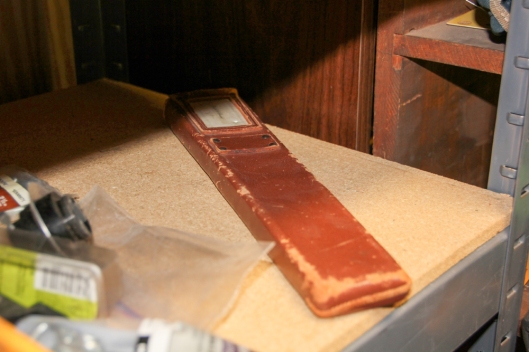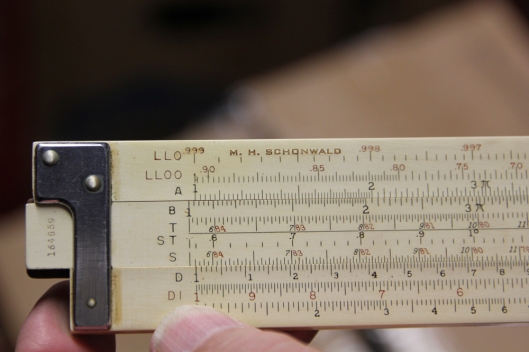Tags
 As I toured my Dad’s new workshop and then his storage shed the item on one of the shelves caught my eye. It was the slide rule in the leather case that I remember from as far back as my memory goes.
As I toured my Dad’s new workshop and then his storage shed the item on one of the shelves caught my eye. It was the slide rule in the leather case that I remember from as far back as my memory goes.
 Dad pulled it out and said he received it as a gift in 1956 or 57. It was not new then but rather the person who gave it to him must have been aware of Dad’s interest in building rockets and engineering. I have to wonder if he received the gift around the time that the local newspaper published an article on March 29, 1956 about my Dad and two of his friends who entered the state science fair with their 45-pound rocket (see Rocket Man blog post).
Dad pulled it out and said he received it as a gift in 1956 or 57. It was not new then but rather the person who gave it to him must have been aware of Dad’s interest in building rockets and engineering. I have to wonder if he received the gift around the time that the local newspaper published an article on March 29, 1956 about my Dad and two of his friends who entered the state science fair with their 45-pound rocket (see Rocket Man blog post).
The slide rule remains in a leather case that my Dad got at an army surplus store that was the case for a WWII B-25 Navigator load adjuster, which was used for aircraft load and balancing. At the time he got the case he put one of his high school graduation name cards in the slot for identification that is still there. On the case is a black tape label with my Dad’s name and address that he made years ago from a dial label maker.

Since I didn’t know how to use the slide rule, Dad showed me a couple of simple multiplication ‘calculations’ using the slide rule. As he looked he noticed a name engraved on the slide rule and he said “oh, that’s who gave it to me, M. H. Schonwald”. Dad thought Mr. Schonwald was a cousin to the Singer family who were the owners of Singer Pipe & Supply where Dad’s family lived and my grandfather worked.

Today, I decided to look up M. H. Schonwald and learned that, among many things, he was the inventor of the motor vehicle oil drip guard US patent 2732024 filed December 16, 1954 and published January 24, 1956. Here’s an excerpt describing Mr. Schonwald’s patent:
The present invention contemplates a novel oil drip guard for the underside of a motor vehicle to receive and collect all of the oil or grease which may drip from the engine or transmission. The guard is secured to the vehicle frame directly under the engine and transmission in such a manner that it will not be affected by wind when the vehicle is driven at high speeds. Further, the guard is secured to the frame in such a manner that it may be easily removed for cleaning or repair. It is also contemplated to provide an absorbent pad on the top surface of the guard, particularly for vehicles having an excessive oil leakage, to absorb the collected oil and prevent spillage of the oil from the guard when the vehicle is tilted or stopped extremely fast.
An important object of this invention is to substantially eliminate oil from dripping onto driveways and garage floors.
Another object of this invention is to provide an oil drip guard for the underside of a motor vehicle which will not be materially affected by Wind, as when the vehicle is driven at high speeds.
Another object of this invention is to provide an easily removable oil drip guard for vehicle engines and transmissions.
A further object of this invention is to prevent spillage of oil collected in a motor vehicle drip guard.
A still further object of this invention is to provide a simple, light-weight motor vehicle oil drip guard which may be economically manufactured.
Other objects and advantages of the invention will be evident from the following detailed description, when read in conjunction with the accompanying drawings, which illustrate one embodiment of my invention.
The fascinating histories that surround us never ceases to amaze me.
Additional Reading
- The Slide Rule: A Computing Device That Put A Man On The Moon – history and description on how to use the slide rule
- Milton H. Schonwald findagrave entry that includes his obituary
- Rocket Man – My Dad and two of his friends decided to enter the state science fair and on March 29, 1956 the local paper published an article about their 45-pound rocket.
- Floorplans and Genealogy (updated in 2018 and renamed 52 Ancestors in 52 Weeks: The Old Homestead) – post I wrote about my grandparents home at Singer Pipe & Supply
